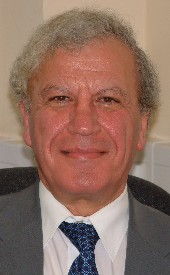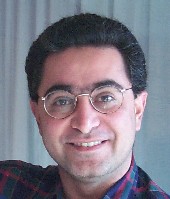| MAIN
PAGE CALL FOR PAPERS KEYNOTE SPEAKERS INVITED LECTURE COMMITTEES AUTHOR'S KIT REGISTRATION PROGRAMME CITY MAP ACCOMMODATION SOCIAL EVENTS SPONSORS VENUE VISA REQUIREMENTS TRAVEL INFORMATION CONTACT INFORMATION COMMENTS - NEW ! PHOTOS - NEW ! |
EC-VIP-MC
2003 On Contours, Corners and Cats: Professor Anthony G. Constantinides Imperial College London Abstract: The complexities of the human visual system are manifold. The way we perceive the world at the "physical layer", as it were, is crucial in providing the pivotal information for further and subsequent human action. The incorporation of some approximation of the human visual attributes within mechanised image processing algorithms pays substantial dividends. It is now well known and extensively used in the image processing community that the so-called "first stage" in visual perception of an image depends on the shape (the "gestalt") of the object represented by the image. There are many algorithms that take advantage of this in order to produce efficient reduced image representation for example for compression. Equally, there are many questions that arise from this "shape" approach to image or contour representation. For example where does the contour information lie and what is the measure of such information? Several authors have made use of the corner estimation idea to produce an image representation that is both compact and adequate from the human perception point of view. The Recursive Shortest Spanning Tree (RSST) and its variants, for image non-pixel based representation essentially make use of some of the above ideas. The early work on human visual perception by Attneave (his "cat" notwithstanding!) on these topics is crucial to providing an understanding and an approach. It has been either explicitly or implicitly the pivot of many successful image representation and compression algorithms. However, the human visual system can be fooled into interpreting falsely many circumstances. The occurrence of false contours is well documented, while optical illusions are part of the games we play with our children. The purpose of the talk is to explore from a quasi-analytical perspective some of the issues related to the above, and to examine such questions as the information in a contour, the presentation of some elementary ideas on false contours and to ask some additional questions on illusions, conceptual or otherwise, relevant to image processing. The final objective from a scientific and engineering perspective is that the resolution or understanding of these problems would enable the development of better techniques for image processing in a spatio-temporal framework. About the Keynote Speaker: A.G. CONSTANTINIDES is the Professor of Signal Processing at Imperial College (London) and the head of the Signal Processing and Digital Systems Section of the Department of Electrical and Electronic Engineering at the same place. He has been actively involved with research in various aspects of digital filter design, digital signal processing, and communications for more than 30 years. Professor Constantinides' research spans a wide range of Digital Signal Processing, both from the theoretical as well as the practical points of view. His recent work has been directed toward the demanding signal processing problems arising from the various areas of telecommunication. This work is supported by research grants and contracts from various government and industrial organisations. Professor Constantinides has published several books and over 200 papers in learned journals in the area of Digital Signal Processing and its applications. He has served as the First President of the European Association for Signal Processing (EURASIP) and has contributed in this capacity to the establishment of the European Journal for Signal Processing. He has been on, and is currently serving as, a member of many technical program committees of the IEEE, the IEE and other international conferences. He has organised the first ever international series of meetings on Digital Signal Processing, in London initially in 1967, and in Florence since 1972. In 1985 he was awarded the Honour of Chevalier, Palmes Academiques, by the French government, and in 1996, the promotion to Officier, Palmes Academiques. He holds honorary doctorates from European and Far Eastern Universities, several Visiting Professorships, Distinguished Lectureships, Fellowships and other honours around the world. Professor Constantinides served as a Member of the Board of Governors of the IEEE Signal Processing Society, a member of several Technical Committees of the IEEE and the IEE, and is on the Editorial Boards of many professional journals. He is a Fellow of the Institute of Electrical and Electronics Engineers (USA) and of the Institution of Electrical Engineers (UK). Novel Frontiers in
Multimedia Communications - Professor Touradj Ebrahimi Swiss
Federal Institute of Technology - EPFL Abstract: The last two decades have witnessed tremendous changes in communications. On one hand, communication has become multimedia, allowing exchange of all sorts of audiovisual content. On the other hand, thanks to the Internet and Mobiles, communication has become seamless and more democratic. Yet at the same time new challenges and new problems have appeared. Communication between machines has become the strong link in the information chain. However, the several-fold increase in computer performance and communication channel bandwidth does not seem to properly reflect in human-machine interfaces, and the good old keyboards, pointing devices, and displays still assure the majority of our interactions with computers. It seems as if Moore's law has not applied with the same rigor to interfaces between human and computers. Research and development in these areas indicate that there is hope that human-machine interaction can extend to other modalities such as interaction through smart cameras (vision), haptics (touch), olfaction (smell), and others, including direct brain-computer interaction. An essential element in any communication is the content. Content can be seen as the recipient in which, we express ourselves. In the history of mankind, we have been successful in finding multiple ways of expression. The obvious audio (music, song …) and visual (painting, photography, film …) expressions are by no means the only channels available to us. As a matter of fact, mechanisms of expression stimulating all our senses, such as haptics (sculptures, clothing …), olfaction (perfumes …), and taste (cuisine …) have always had a strong impact in culture and art. Electronic and digital communication has not been very successful so-far in taking full advantage of content beyond audiovisual modalities as vectors of expression. In this talk, we take an original look at the history of communications, and based on the past trends, analyse alternatives in which future communication systems may look like. Doing so, we will define what could define the future media, and outline the importance of man-machine interface, as the weak link of communications in today's systems. About the Keynote Speaker: Touradj Ebrahimi received M.Sc. and Ph.D., both in Electrical Engineering, from the Swiss Federal Institute of Technology, Lausanne (EPFL), in 1989 and 1992 respectively. In 1993, he was a research engineer at the Corporate Research Laboratories of Sony Corporation in Tokyo, where he conducted research on advanced video compression techniques for storage applications. In 1994, he was as a researcher at AT&T Bell Laboratories working on very low bitrate video coding. Touradj is currently a Titular Professor at the Signal Processing Institute of the School of Engineering at EPFL, where he is involved in research and teaching for Multimedia Information Processing and Coding. In 2002, he founded Emitall, a research and development company in electronic media innovations. Touradj was the recipient of the IEEE and Swiss national ASE award in 1989, and the winner of the first price for the best paper appeared in IEEE Transactions on Consumer Electronics in 2001. In 2001 and 2002, he received two ISO awards for contributions to MPEG-4 and JPEG 2000 standards. He is author or co-author of over 100 scientific publications and holds a dozen patents. H.264/MPEG-4 Part 10 Advanced Video Coding Professor K. R. Rao Electrical
Engineering Department Abstract: The keynote speech will present an introduction to Joint Video Team (JVT) that is a joint effort by ITU-T VCEG (video coding experts group) and ISO/IEC MPEG organizations with the objective of developing a common standard for coding video sequences at approximately half the bitrate compared to MPEG-2 at the same quality. This new standard will achieve this performance edge across a very wide variety of applications ranging from low bit rate, low-resolution video to HDTV resolutions. It aims at having significant improvements in coding efficiency, error robustness and network friendliness. It will be known as H.264 (ITU-T) and MPEG-4 Part 10 (ISO/IEC). This is projected to be an International Standard by May 2003. The seminar will also highlight main differences in the coding of I, P and B pictures between this standard and MPEG-2. Intra pictures exploit spatial correlation to improve the performance of the coder. P pictures use multiple reference pictures, different block sizes for motion estimation and motion vector prediction to improve the coding efficiency. Use of direct mode and bi-predictive mode in B pictures results in increased performance. The new standard also allows the use of Arbitrary Block-size Transform (ABT), which is a simplified transform that avoids the mismatch error (DCT/IDCT) observed in the motion compensation hybrid coding adopted in MPEG-1 and MPEG-2. All these features along with others such as CABAC (Context Based Adaptive Binary Arithmetic Coding) have resulted in having a 2:1 coding gain over MPEG-2 at the cost of increased complexity. Web/ftp sites will be provided. About the Keynote Speaker: K. R. Rao received the Ph. D. degree in electrical engineering from The University of New Mexico, Albuquerque in 1966. Since 1966, he has been with the University of Texas at Arlington where he is currently a professor of electrical engineering. He, along with two other researchers, introduced the Discrete Cosine Transform in 1975 which has since become very popular in digital signal processing. He is the co-author of the books "Orthogonal Transforms for Digital Signal Processing" (Springer-Verlag, 1975), "Fast Transforms: Analyses and Applications" (Academic Press, 1982), "Discrete Cosine Transform - Algorithms, Advantages, Applications" (Academic Press, 1990). He has edited a benchmark volume, "Discrete Transforms and Their Applications" (Van Nostrand Reinhold, 1985). He has coedited a benchmark volume, "Teleconferencing" (Van Nostrand Reinhold, 1985). He is co-author of the books, "Techniques and standards for Image/Video/Audio Coding" (Prentice Hall) 1996 and "Packet video communications over ATM networks" (Prentice Hall) 2000. He has coedited a handbook " The transform and data compression handbook," (CRC Press, 2001). Some of his books have been translated into Japanese, Chinese, Korean and Russian. He has conducted workshops/tutorials on video/audio coding/standards worldwide. He has published extensively in refereed journals and has been a consultant to industry, research institutes and academia. He is a Fellow of the IEEE. |


